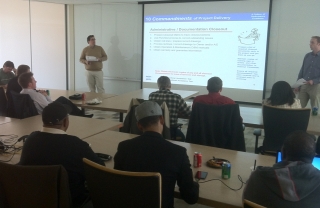|
Subscribe / Renew |
|
|
Contact Us |
|
| ► Subscribe to our Free Weekly Newsletter | |
| home | Welcome, sign in or click here to subscribe. | login |
Construction
| |

September 13, 2012
Boost program gives subs an inside track
Special to the Journal
In today's economy, local contractors are looking for any advantage they can get to outbid the competition.
Small contractors, such as Titan Earthwork, are particularly motivated to get a foot in the door with larger general contractors.
A program offered by Skanska gives contractors like Titan a chance to increase their workload in a competitive market.
The 10-week Boost Construction Management Accelerator Program offered by Skanska gives small and minority-owned contractors insights into how companies like Skanska work and what they look for in bids from subcontractors.
Josh Vogt, regional program manager for Titan, a Sumner civil construction firm of about 40 employees, said the Boost program is a “good opportunity to learn from global leaders in our industry what processes they use.” The program is helpful, for example, in learning about bidding and scheduling, he said.
From Skanska's perspective, the program allows the company to teach others ways to find jobs.
“Our focus is to teach them (subcontractors) how to win work,” said Skanska's Northwest diversity manager Mel Jones. “We want to teach them how to win and keep winning.”
Boost participants are given the inside track on how to present scope letters; insurance and bonding requirements for a particular job; how to estimate costs; and LEED tracking.
“This is not just a set of boring PowerPoint presentations,” said Jones. “We make it very interactive.”
Jones said Skanska looks for subcontractors who know exactly what it needs, which can also save time.
“We receive information for a project that may include 20 different trades that cover excavating and framing to drywall and landscaping,” he said. “With these 20 trades we can have anywhere from five to 15 different contractors each. This means that our team will have to sort through sometimes as many as 200 different responses from subcontractors to try to choose which number we will use in our pricing to the client.”
Skanska's live bidding class walks Boost participants through this process to show them why certain elements of the bid are important, such as the scope letter. This letter, he said, spells out what items are included in the number that the subcontractor submits to the prime contractor.
“Identifying items in your scope letter helps us to know how complete your proposal is without wasting our time,” he said. “Those exclusions or inclusions can be made up in other areas if they are known in advance.”
In the Boost course, which requires students to attend class two hours a week, instructors take students through one project, from beginning to end.
“When they go through these steps, they get a better understanding of what the general contractor is looking for so they know what to provide us, and what the submittal packages and documents should look like,” he said.
In Titan's case, Vogt said the firm was searching for a way to build a partnership with Skanska to win future work. He said Skanska officials may recognize a bid from one of its Boost program participants, which can give the bidder an advantage.
Vogt said the course is an ideal way to meet Skanska decision makers. “It was an excellent opportunity to network within Skanska and get face-to-face time with them,” he said. “It's important to learn how bigger corporations handle their bureaucracy.”
During the course, Jones said students meet as many as 15 Skanska managers and build relationships with them.
For Carlton Lewis of Tacoma-based Farrow Construction Specialties, the Boost program solidified an ongoing relationship his small concrete company had with Skanska before he participated in the program.
“It certainly helped us raise our level of playing, which is important to us because Skanska has been one of our larger clients over the years,” said Lewis. “Everyone's trying to differentiate themselves and create additional value to the contracting equation. The Boost program helps set our company apart.”
Previous columns:
- Confusion surrounds independent duty doctrine, 09-06-2012
- PBS documentary profiles Oregon Caves Chateau, 08-30-2012
- Bike & Build: National nonprofit combines fundraising, construction and a 4,000-mile ride, 08-23-2012
- Crews face unique challenges when the construction zone is in a hospital, 08-16-2012
- Contractors sweat the details of Seattle's complex sick leave law, 08-09-2012
- Challenge for rehab team: Put roofing on walls, 08-02-2012
- Purple and gold students fashion green walls, 07-26-2012
- L&I's new Stay at Work program keeps 1,200 injured workers on the job, 07-19-2012



